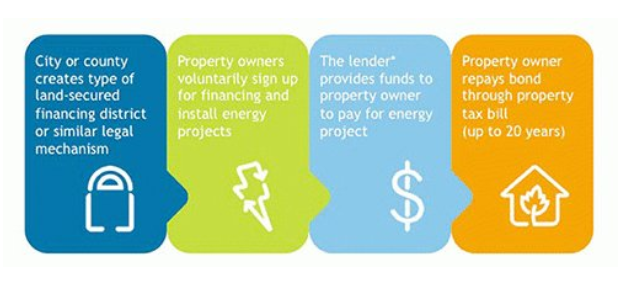Highlights
- Property Assessed Clean Energy (PACE) is an innovative financing mechanism for energy efficiency or renewable energy projects where the debt is serviced through an assessment on the building’s property taxes.
- PACE loans are typically lower interest than traditional mezzanine financing and shift energy efficiency financing from a capital to an operating expense.
- The Texas “Pace in a Box” Toolkit is an exhaustive resource including model documents and contracts, case studies from communities and projects throughout Texas, and more
What Is PACE?
In 2013, the Texas legislature created Chapter 399 of the Texas Local Government Code, which gives the local governments the authority to develop a Property Assessed Clean Energy (PACE) District, which works with private sector lenders and property owners to secure financing for qualified improvements using an assessment on the property.
While local governments cannot use PACE financing to finance municipal projects, local governments play a key role in creating PACE districts to stimulate economic investment. This is an innovative financing program that allows commercial and industrial property owners the opportunity to obtain low-cost, long-term loans for energy efficiency or renewable energy projects.
Under the PACE financing model, property owners borrow money to implement projects and make repayments on those loans through an assessment on their property tax bill. PACE loans are unique in that they stay with the property, not the original borrower.
PACE financing can be used for industrial, commercial, and multifamily residential properties over 5 units. Buildings must be located within a PACE region in order to utilize PACE financing. A list of common qualifying measures under PACE can be found at the Keeping PACE in Texas website.
 Image Source: US Department of Energy
Image Source: US Department of Energy
What are the Benefits of PACE
The PACE program provides building owners with 100% upfront financing of the cost of the project, eliminating upfront costs that typically inhibit energy efficiency investments. Because property owners will quickly see reductions in their energy bills due to the improvements financed by PACE, the program creates a positive return on investment from day one.
PACE is designed to enhance the value and efficiency of existing buildings, reduce energy demand, promote job growth, and significantly save building owners on utility costs. This type of secured financing does not affect conventional lending sources and will not compete for capital with other building owner investment opportunities.
Case Study: Creating the First PACE District in Texas
In 2015, Travis County became the first local government in Texas to establish a PACE district.
The State Energy Conservation Office (SECO), HARC, and SPEER created a case study detailing Travis County’s experience – including what steps Travis County needed to take to create a PACE district, what stakeholders were involved, and more.
Read the Creating the First PACE District in Texas case study.
Currently Adopted PACE Districts in Texas
Texas PACE Authority keeps an updated map of where PACE financing is currently available in Texas. View the map to find out if PACE is available in your area.
Texas 'PACE in a Box' Toolkit
A coalition of over 100 PACE stakeholders developed a document, the “PACE in a Box” Toolkit, that includes all of the information a local government needs to create a PACE program.
The toolkit is an exhaustive resource that contains model documents and contracts, case studies from communities and projects throughout Texas, and more. By utilizing these standard documents and program design guidelines, PACE programs can be designed in a uniform format among regions in Texas which allows financial stakeholders to easier utilize PACE financing throughout Texas.
Access the “PACE in a Box” toolkit here.
 Image Source:
Image Source: